
The Lycopodiaceae are an old family of vascular plants, including all of the core clubmosses and firmosses, comprising 16 accepted genera and about 400 known species. This family originated about 380 million years ago in the early Devonian, though the diversity within the family has been much more recent. "Wolf foot" is another common name for this family due to the resemblance of either the roots or branch tips to a wolf's paw.

Lycopodium is a genus of clubmosses, also known as ground pines or creeping cedars, in the family Lycopodiaceae. Two very different circumscriptions of the genus are in use. In the Pteridophyte Phylogeny Group classification of 2016, Lycopodium is one of nine genera in the subfamily Lycopodioideae, and has from nine to 15 species. In other classifications, the genus is equivalent to the whole of the subfamily, since it includes all of the other genera. More than 40 species are accepted.

Lycopodium clavatum is the most widespread species in the genus Lycopodium in the clubmoss family.

Diphasiastrum is a genus of clubmosses in the plant family Lycopodiaceae. In the Pteridophyte Phylogeny Group classification of 2016, it is placed in the subfamily Lycopodioideae. It is closely related to the genus Lycopodium, and some botanists treat it within a broad view of that genus as a section, Lycopodium sect. Complanata. Some species superficially resemble diminutive gymnosperms and have been given common names such as ground-pine or ground-cedar.

Lycopodiella is a genus in the clubmoss family Lycopodiaceae. The genus members are commonly called bog clubmosses, describing their wetland habitat. The genus has a cosmopolitan distribution, with centers of diversity in the tropical New World and New Guinea. In the past, the genus was often incorporated within the related genus Lycopodium, but was segregated in 1964. In the Pteridophyte Phylogeny Group classification of 2016, Lycopodiella is placed in the subfamily Lycopodielloideae, along with three other genera. In this circumscription, the genus has about 15 species. Other sources use a wider circumscription, in which the genus is equivalent to the Lycopodielloideae of PPG I, in which case about 40 species and hybrids are accepted.
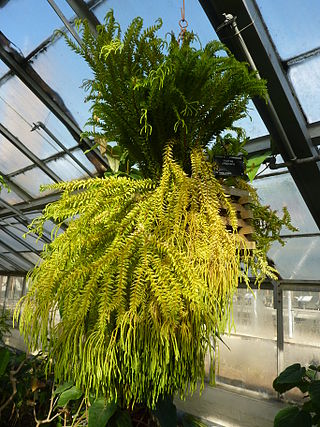
Phlegmariurus phlegmaria, synonym Huperzia phlegmaria, commonly known as either coarse tassel fern or common tassel fern, is an epiphytic species native to rainforests in Madagascar, some islands in the Indian Ocean, Asia, Australasia and many Pacific Islands. Phlegmariurus phlegmaria is commonly found in moist forests and rainforests at high altitudes, in and amongst mosses and other epiphytes. Members of the order Lycopodiales are commonly referred to as clubmosses.

Diphasiastrum complanatum, common names groundcedar, creeping jenny, or northern running-pine, is a species of clubmoss native to dry coniferous forests in colder northerly parts of the world. Under the original name Lycopodium complanatum, this was an inclusive superspecies that included a number of other species now known to be biologically separate. This plant is an evergreen, perennial pteridophyte. The spores are produced June to September.

Dendrolycopodium dendroideum, synonym Lycopodium dendroideum, known as tree groundpine, is a North American species of clubmoss. It is part of a complex of species colloquially known as groundpine, which taxa were formerly lumped into the species Lycopodium obscurum. The species is native to Russia and also to the colder parts of North America. The genus Dendrolycopodium is accepted in the Pteridophyte Phylogeny Group classification of 2016, but not in other classifications, which submerge the genus in Lycopodium.

Lycopodium powder is a yellow-tan dust-like powder, consisting of the dry spores of clubmoss plants, or various fern relatives. When it is mixed with air, the spores are highly flammable and are used to create dust explosions as theatrical special effects. The powder was traditionally used in physics experiments to demonstrate phenomena such as Brownian motion.

Sceptridium dissectum is a common fern in the family Ophioglossaceae, occurring in eastern North America. Like other plants in this group, it normally only sends up one frond per year. It has long been the subject of confusion because the frond presents in one of two forms, either the normal form that resembles other plants in the genus, or the skeletonized form.
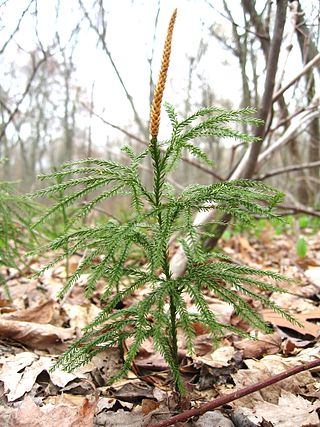
Dendrolycopodium obscurum, synonym Lycopodium obscurum, commonly called rare clubmoss, ground pine, or princess pine, is a North American species of clubmoss in the family Lycopodiaceae. It is a close relative of other species such as D. dendroideum and D. hickeyi, also treelike. It is native to the eastern United States and southeastern Canada from Georgia to Minnesota to Nova Scotia. It grows in the understory of temperate coniferous and deciduous forests, where it is involved in seral secondary succession, growing in clonal colonies some years after disturbance has occurred. It has also been found in Japan, Taiwan, Korea, Russian Far East, and northeastern China.
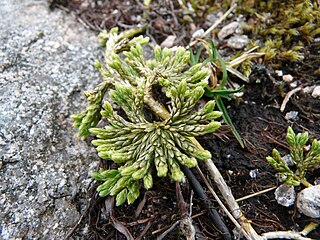
Diphasiastrum alpinum, the alpine clubmoss, is a species of clubmoss. This plant is a glaucous scale-leaved perennial pteridophyte. In Finland, the spores are produced June to September. It was first described by Carl Linnaeus in his Flora Lapponica, 1737, from specimens obtained in Finland.

Diphasiastrum sitchense, the Sitka clubmoss, is a pteridophyte species native to northern North America and northeastern Asia. It is a terrestrial herb spreading by stolons running on the surface or the ground or just slightly below the surface. Leaves are appressed, broadly lanceolate, up to 3.2 mm long. Strobili are solitary on the ends of shoots. It is known from every province in Canada, plus the US States of Alaska, Oregon, Washington, Idaho, Montana, Maine, New Hampshire, Vermont, and New York. It is also found in Greenland, St. Pierre and Miquelon, Yukon, Japan, and the Kamchatka Peninsula of Asiatic Russia. It can be found in alpine meadows, open rocky barrens, and coniferous woodlands.
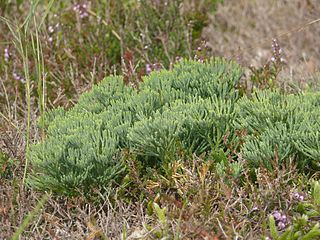
Diphasiastrum tristachyum, commonly known as blue clubmoss, blue ground-cedar, ground pine, deep-rooted running-pine or ground cedar, is a North American and Eurasian species of clubmoss. In North America, it has been found from Newfoundland west to Manitoba, and south as far as Georgia and Alabama. In Eurasia, it ranges from southern Norway and Sweden south to France and Italy and it also occurs in the Caucasus.
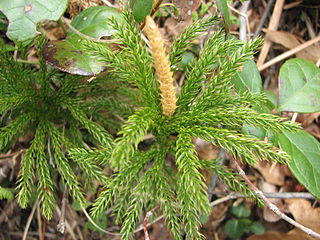
Dendrolycopodium hickeyi known as Hickey's tree club-moss or Pennsylvania clubmoss, is a North American species of clubmoss in the family Lycopodiaceae. It is native to eastern and Central Canada and the eastern and north-central United States. The genus Dendrolycopodium is accepted in the Pteridophyte Phylogeny Group classification of 2016, but not in other classifications, which submerge the genus in a larger Lycopodium.

Lycopodiella alopecuroides, the foxtail clubmoss, is a species of perennial vascular plant in the club-moss family, Lycopodiaceae. It is commonly found along the Atlantic seaboard and has been recently been discovered in the state of Maine. The family, Lycopodiaceae contains nearly 15 genera and about 375 species
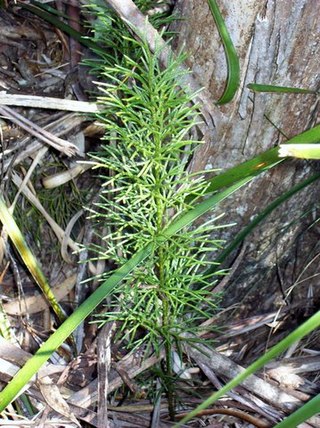
Pseudolycopodium is a genus of lycophyte in the family Lycopodiaceae with only one species, Pseudolycopodium densum, known as the bushy clubmoss. In the Pteridophyte Phylogeny Group classification of 2016, the genus is placed in the subfamily Lycopodioideae. Some sources do not recognize the genus, sinking it into Lycopodium. Pseudolycopodium densum is native to Australia, the North Island of New Zealand and New Caledonia. It is a spore-bearing vascular plant and grows up to a metre high. It is found in a wide variety of situations, often in high rainfall areas on sandy soils.

Lycopodioideae is a subfamily in the family Lycopodiaceae in the Pteridophyte Phylogeny Group classification of 2016. It is equivalent to a broad circumscription of the genus Lycopodium in other classifications. Like all lycophytes, members of the Lycopodioideae reproduce by spores. The oldest fossils of modern members of the subfamily date to the Early Cretaceous.

Lycopodielloideae is a subfamily in the family Lycopodiaceae in the Pteridophyte Phylogeny Group classification of 2016. It is equivalent to a broad circumscription of the genus Lycopodiella in other classifications. Like all lycophytes, members of the Lycopodielloideae are vascular plants that reproduce by spores.


















